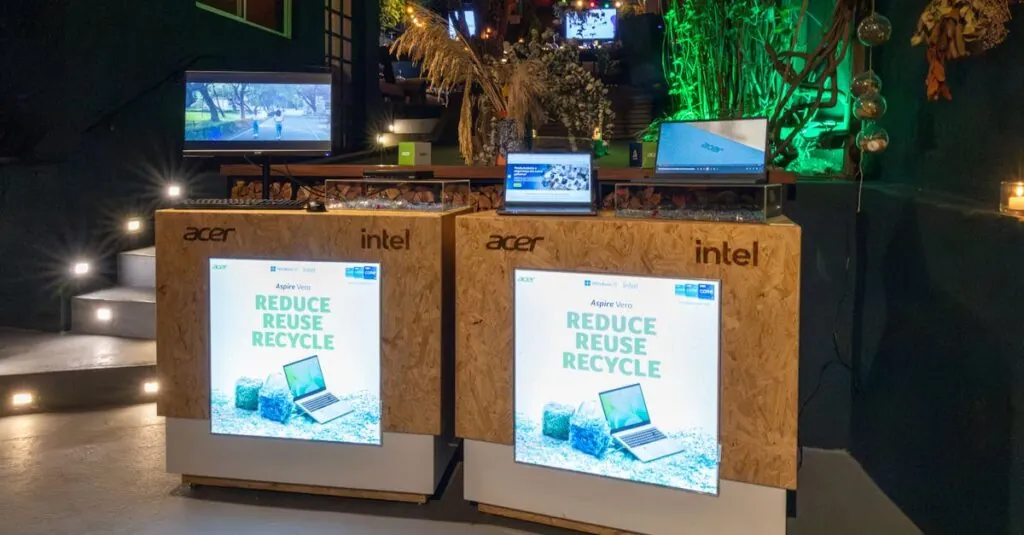Table of Contents
ToggleIn a world where laptops seem to multiply faster than rabbits, the question of what happens to them when they outlive their usefulness becomes crucial. Enter the age of recyclable laptops—where tech meets eco-friendliness in a beautiful union that even Mother Nature would approve of. Why toss your old laptop into a landfill when you can give it a second life?
Overview of Recyclable Laptops
Recyclable laptops represent a crucial step toward sustainable technology. These devices contain materials that can be recovered and reused, significantly reducing electronic waste. Manufacturers design these laptops with recyclable components in mind, facilitating easier disassembly and material recovery.
Components like metals, plastics, and glass are frequently found in these laptops. Metals such as aluminum and copper can be extracted, while plastics can undergo reprocessing into new products. Glass screens typically get recycled into new glass products or used in construction materials.
Several manufacturers have initiated programs aimed at encouraging recycling. For instance, companies offer trade-in options that allow users to return old devices for credit towards new purchases. This process not only promotes recycling but also incentivizes responsible consumer behavior.
Environmental benefits linked to recyclable laptops are substantial. Utilizing recycled metals reduces the need for mining, which decreases habitat destruction and pollution. Statistics suggest that recycling one million laptops conserves energy equivalent to the electricity used by more than 3,500 households per year.
Responsibility for recycling also extends to consumers. Proper disposal methods ensure that hazardous materials do not harm the environment. Many communities provide local e-waste recycling events, making it convenient for individuals to participate.
Innovative technologies enhance the recyclability of laptops. Modular designs allow for easy upgrades and repairs, extending the device’s lifespan. The trend combines user convenience with environmental consciousness, contributing to a more sustainable electronic lifecycle.
Benefits of Recyclable Laptops
Recyclable laptops offer multiple benefits, positively impacting both the environment and the economy. These advantages underscore their importance in a sustainable technological landscape.
Environmental Impact
Environmental benefits of recyclable laptops significantly reduce electronic waste. Recycling one million laptops can save energy equivalent to what 3,500 households consume annually. Reducing landfill overflow helps prevent hazardous materials from contaminating soil and water sources. Additionally, manufacturers design laptops with reusable metals, plastics, and glass, facilitating easier recovery. Lowering the demand for new materials further supports sustainable resource management. Communities that promote recycling programs encourage responsible disposal practices, ensuring more laptops enter the recycling stream instead of landfills. Innovative modular designs enhance recyclability, allowing users to upgrade or repair laptops instead of discarding them.
Economic Advantages
Economic benefits of recyclable laptops include significant cost savings. Manufacturers often provide trade-in programs, allowing consumers to receive credit for returning old laptops. This reimbursement fosters responsible consumer choices while encouraging new purchases. The reduced demand for raw materials translates into lower production costs, benefiting manufacturers and consumers alike. Job creation in the recycling sector also plays a key role. Recycling programs generate employment opportunities in material recovery and processing. This shift contributes to a circular economy, where electronic components are reused, generating additional revenue while minimizing waste.
Key Features of Recyclable Laptops
Recyclable laptops combine innovative technology with sustainable practices, making them an important choice for environmentally conscious consumers. Two key features stand out: sustainable materials and modular design.
Sustainable Materials
Laptops designed for recyclability utilize materials that reduce environmental impact. Aluminum and copper comprise the metal components, offering high recyclability rates and durability. Plastics used in these devices often come from recycled sources, minimizing new plastic production. Glass screens present another recyclable option, contributing to the overall sustainability of these products. Each material can be repurposed into new items, thereby conserving resources. Programs from manufacturers promote the collection and recycling of these materials, further enhancing their eco-friendly credentials.
Modular Design
Modular design enhances the recyclability of laptops by allowing easy upgrades and repairs. Components like memory and storage can be replaced, extending the device’s lifespan. This design approach minimizes electronic waste by enabling users to upgrade instead of discard. Some manufacturers implement screws instead of adhesive, simplifying disassembly for recycling purposes. Additionally, this design fosters user engagement while promoting a circular economy. Each modular laptop supports responsible consumption, reducing the overall demand for new materials.
Leading Brands in Recyclable Laptops
Several prominent brands have stepped up to lead the charge in recyclable laptops. Apple emphasizes sustainability with its MacBook lineup, featuring recyclable aluminum enclosures and recycled rare earth elements in components. Dell also stands out with its Latitude series, which utilizes recycled materials while promoting a circular economy through robust recycling programs.
HP prioritizes recyclability by designing laptops like the HP Elite Dragonfly, crafted from ocean-bound plastic and featuring easy-to-recycle materials. Lenovo, recognized for innovative designs, incorporates sustainable practices in its ThinkPad series, ensuring compatibility with recycling efforts and modular upgrades.
Asus advocates for environmental responsibility with its VivoBook and ZenBook lines, which utilize recycled plastics and eco-friendly packaging. Samsung further enhances its green credentials with its Galaxy Book series, engaging in commitments to reduce electronic waste through responsible recycling initiatives.
The investment in recycling initiatives promotes not only brand loyalty but also encourages consumers to trade in old devices. Many companies offer trade-in programs, allowing users to exchange their old laptops for credit toward new purchases, turning the recycling experience into a rewarding exchange. Environmental benefits stem from these efforts; recycling a million laptops conserves enough energy to power over 3,500 households annually.
Brands drive the transition toward a more sustainable future. They design laptops with materials like aluminum, copper, and recycled plastics, ensuring easy disassembly and material recovery. This focus on sustainable production creates an ecosystem where products are reused and repurposed, aligning with global sustainable development goals. Industry leaders showcase a commitment to reducing electronic waste and promoting a circular economy, marking a crucial step forward in technology and environmental stewardship.
Challenges and Considerations
Recyclable laptops face several challenges that impact their broader adoption. For one, consumers often lack awareness of recycling options. Many individuals may not know about available programs or how to properly recycle their devices. Education plays a vital role in overcoming this barrier.
Manufacturers also encounter difficulties in sourcing sustainable materials. Finding high-quality recyclable components that meet performance standards can be challenging. Innovations in material science are necessary to enhance the sustainability of laptop designs.
Logistical issues present another challenge. Collection and distribution systems for recyclable electronics often require improvement. Effective infrastructure ensures that devices are efficiently collected and processed, maximizing recycling efforts.
The cost associated with recycling programs is another consideration. Implementing robust programs can incur significant investments for manufacturers. Financial incentives may encourage greater participation from consumers, but companies must balance costs with environmental responsibilities.
Evolving regulations pose challenges as well. Governments around the world are establishing strict guidelines for electronic waste disposal. Adhering to these regulations requires continuous updates from manufacturers regarding compliance efforts.
Consumer engagement is crucial for effective recycling. Encouraging responsible disposal behaviors can significantly enhance the recycling rates of laptops. Engaging campaigns and incentives can motivate users to take action.
Ultimately, tackling these challenges requires collaboration between consumers, manufacturers, and governments. Establishing a well-informed community, promoting sustainable practices, and improving recycling infrastructure can pave the way for a greener future in laptop technology.
Conclusion
Recyclable laptops are paving the way for a more sustainable future in technology. By prioritizing eco-friendly materials and modular designs, manufacturers are making it easier for consumers to engage in responsible disposal practices. The environmental and economic benefits of recycling these devices are significant, contributing to reduced electronic waste and promoting a circular economy.
As awareness grows and more brands commit to sustainability, it’s essential for consumers to take action. Participating in recycling programs and choosing recyclable options can make a meaningful impact. Together, individuals and companies can drive the shift toward a greener tech landscape, ensuring that laptops serve not just as tools but as part of a sustainable ecosystem.




